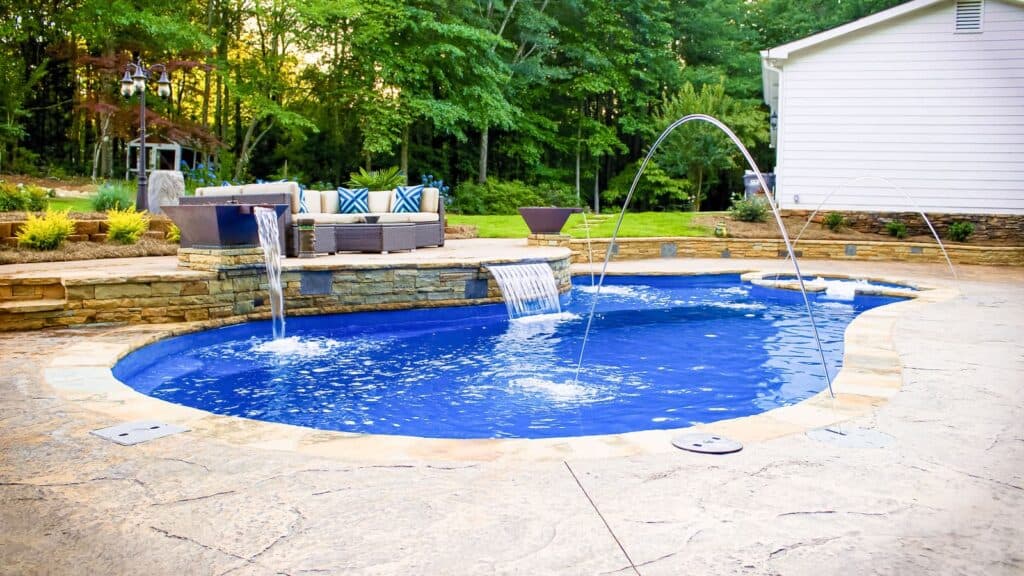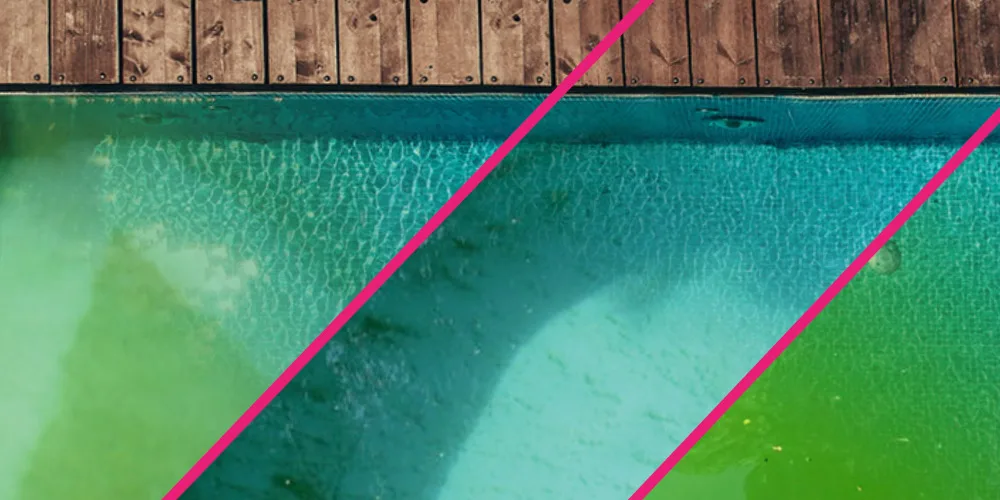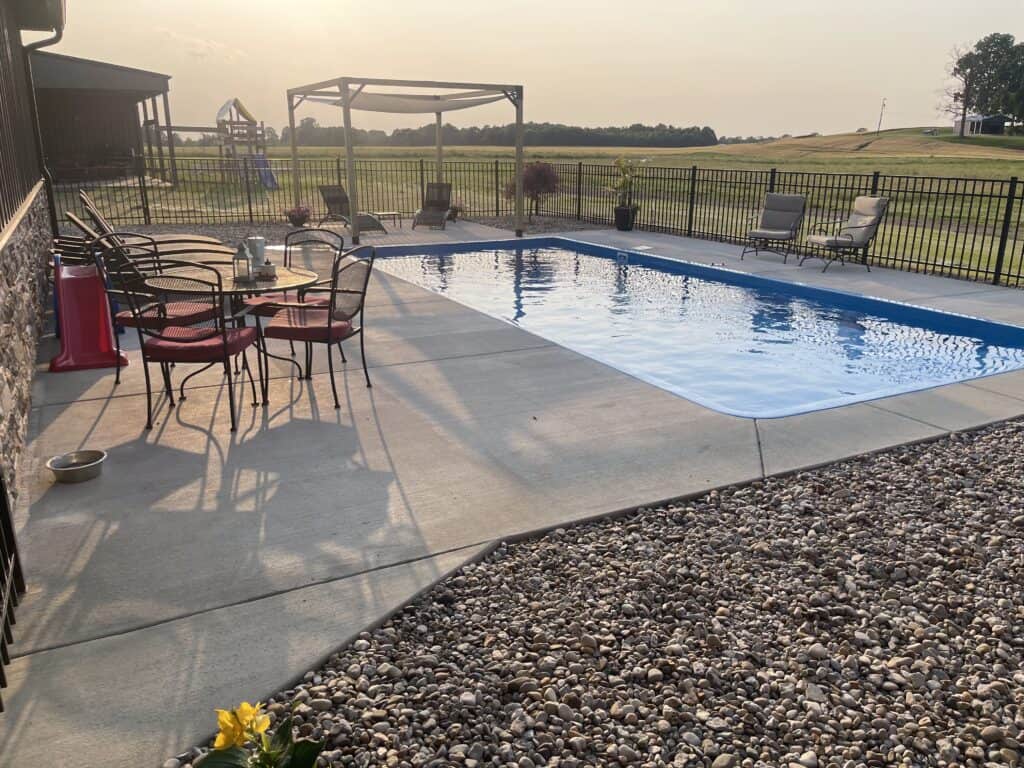Dreaming of that perfect backyard oasis but worried about the fiberglass pool cost standing between you and endless summer memories? Understanding the real investment behind that shimmering blue water is the first step toward making an informed decision for your family and home.
The truth is, fiberglass pool costs involve much more than just the initial price tag. They are a long-term investment with considerations that many homeowners overlook until they’re midway through their project. Let’s dive into what really determines how much you’ll spend to bring your backyard dreams to life.
Contents
Understanding the Main Cost Drivers
Fiberglass pool cost can vary significantly for a complete installation, with the total price depending on factors like size, site conditions, and regional labor rates. This price varies based on several key factors that directly impact your investment.
The pool’s size significantly affects cost. Small pools generally cost less than larger pools.

Site Preparation and Excavation
Your property’s characteristics can dramatically impact excavation expenses. Rocky soil, high water tables, or limited equipment access can add extra expenses to your project.
Sloped yards often require retaining walls or specialized engineering, which can increase the overall site preparation budget.
Our article about DIY pool installations will give you a better understanding of all the factors to keep in mind when it comes to installation day. And don’t worry – you don’t have to do it yourself. That’s when you’ll contact Pool Brokers USA for all of our expert knowledge.
Shell Quality and Manufacturer
Not all fiberglass shells offer the same value. Premium manufacturers provide thicker shells with multiple layers of resin and fiberglass that resist flexing and cracking.
Higher-quality shells may increase your fiberglass pool cost upfront but typically include better warranties and fewer long-term issues.
Permits and Safety Regulations
Local building permits will add to your budget and vary based on municipal regulations. Most areas require specific safety features that add to your budget:
- Fencing requirements: $1,500-$3,000 for code-compliant pool barriers
- Safety covers: $1,000-$2,500 for manual covers that meet safety standards
- Electrical permits: $200-$500 for proper equipment installation
Exploring Popular Pool Add-Ons and Upgrades
The base fiberglass pool cost is just your starting point. Many homeowners enhance their pool with features like hot tubs that improve comfort and aesthetics.
These upgrades can significantly increase your overall project budget depending on your selections.

Heating Equipment and Covers
Pool heaters vary in price based on type and energy efficiency, from simpler solar options to advanced heat pumps. Automatic covers provide safety and reduce evaporation, although they represent a higher investment upfront.
These investments often pay for themselves through reduced chemical and heating expenses over time.
Custom Lighting, Water Features, and Decking
Enhancing your pool area with popular features can transform your backyard experience:
- LED lighting packages: $500-$1,500
- Water features (bubblers, waterfalls): $1,000-$3,000
- Decking options: $6-$30 per square foot depending on material
Comparing Fiberglass With Other Pool Options
Fiberglass pools typically cost more upfront than vinyl liner pools but less than concrete options. The initial investment for fiberglass pools is generally higher than vinyl liner pools but lower than concrete options.
This price difference makes more sense when you consider lifetime expenses.
Upfront Investment vs. Long-Term Savings
While the initial cost may be higher than vinyl, fiberglass pools require significantly less maintenance. Vinyl liners periodically need replacement over the years, which adds to long-term ownership expenses.
Concrete pools demand more frequent specialized upkeep and resurfacing, which leads to higher long-term maintenance expenses.
Repairs and Resurfacing Needs
Fiberglass pools rarely need major structural repairs. Their non-porous surface resists staining and algae growth, reducing the need for chemicals and scrubbing.
Most fiberglass pools maintain their appearance and structural integrity for decades with proper water chemistry.
Maintenance Expenses and Lifespan
Fiberglass pool owners typically have lower annual costs for chemicals, electricity, and general upkeep compared to other pool types.
Most fiberglass pools last 25+ years without major renovations.
Reduced Algae and Chemical Bills
The smooth, non-porous surface of fiberglass pools naturally resists algae growth. This means less scrubbing and fewer chemicals, resulting in notable savings compared to other pool materials.
Many owners report using significantly fewer chemicals, helping offset the initial fiberglass pool investment.

Don’t let algae build up in your pool! Fiberglass pool models can help.
Future Repairs and Warranty Coverage
Quality fiberglass pools typically come with extensive warranty protection:
- Structural warranties: 25-50 years on the shell
- Gel coat finishes: 10-15 year coverage against blistering or delamination
- Equipment warranties: 1-3 years on pumps, filters, and other components
These comprehensive warranties provide peace of mind against unexpected repair costs.
Budgeting for a Fiberglass Pool on Your Own Terms
Smart homeowners can reduce their fiberglass pool budget by exploring alternative installation approaches. Breaking down the project into components allows you to control expenses while still getting the backyard of your dreams.
This approach puts you in control of your investment.
Financing Tips and Seasonal Discounts
Timing your purchase strategically can reduce your fiberglass pool cost:
-
Off-season discounts: Purchasing in fall or winter can save you 5–10% compared to peak season pricing. Many dealers offer incentives to keep crews busy during slower winter months, and you may benefit from faster installation timelines with a pool that’s completely ready for summer fun.
-
Home equity options: A home equity loan or line of credit (HELOC) often offers the lowest rates for qualified homeowners, with the added bonus of potential tax-deductible interest. These are especially attractive for larger projects, though they do involve putting your home up as collateral.
-
Early-buy programs: Some manufacturers and dealers provide discounts or price locks for customers who commit before spring. Not only can this save money, but it can also help you beat the seasonal rush.
-
Fast, flexible financing: If you prefer a personal loan with no home equity requirement, consider programs like VistaFi and HFS Financial. Both offer up to 20-year terms, fast funding (within 48 hours), and no prepayment penalties, making them ideal for homeowners who want fixed monthly payments without refinancing their home. Plus, inquiring won’t impact your credit score so you can explore your options risk-free.
Making the Move to Fiberglass
When you’re ready to transform your backyard, choosing the right partner makes all the difference. A fiberglass pool represents not just a beautiful addition to your home but a long-term investment in family memories.
The total fiberglass pool cost delivers value that extends far beyond the initial price tag.

Request a Personalized Estimate
Every backyard is unique, and so is every pool project. Getting a customized quote helps you understand exactly what your dream pool will cost based on your specific needs and property.
Pool Brokers USA specializes in helping homeowners navigate the process with transparent pricing and flexible installation options that put you in control. Contact us for a quote to get custom pricing on your backyard pool project.
